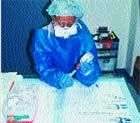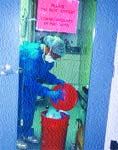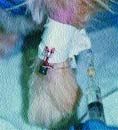Take precautions when using chemotherapeutic drugs
All hospital personnel should be aware of the following procedures for handling chemotheraputic drugs.
Personnel
All hospital personnel should be aware of the following procedures for handling chemotheraputic drugs.
- Potential exposure to themselves and the environment.
Exposure is most often through inhalation of aerosolized particles, direct absorption through skin contact, indirect contact from unprotected hand-to-face contact or accidental ingestion from eating/drinking or smoking via hand-to-mouth contact.
- The safety concerns and proper methods of cleaning up after patients and spills.
- Proper disposal methods of used vials and expired drugs as well as equipment used.
Hospital staff members who are trying to conceive, are pregnant, breastfeeding or are immunosuppressed should refrain from administering chemotherapy.
Patients
Chemo patients should be clearly identified while in the hospital. A different colored name tag/ID band and cage label will help hospital staff know to use extra precautions when dealing with these patients. A brightly colored waterproof chemotherapy laundry bag is recommended.

Use of biohazard containers are an important safety precaution.
Storage
- Store in a separate, secure area to other medications like you would controlled drugs.
- Keep away from areas of food/drink preparation and storage.
- Each open bottle should be separately stored in a zip-lock bag and kept within the container.
- Certain drugs need to be dated and the strength marked on the bottle, as once reconstituted they are only good for a certain period of time. Read drug inserts and manufacturers' instructions regarding storage temperature and time.
- All boxes should be labeled with chemotherapy or hazard labels.
It is useful to have three Tupperware containers; one for unopened drugs, one for open drugs and one in a secure cupboard for drugs not requiring refrigeration.
Safety equipment required
- Nitrile gloves (or double up on unpowdered latex exam gloves).
- Respirator mask – surgical masks are not advised.
- Impermeable gown
- Safety goggles
- Nurse's cap
Drug preparation
Drug calculations should always be double checked.
All safety gear is to be worn and extreme care used when reconstituting chemotherapy drugs. Respirator mask should be fitted snugly onto the face to ensure one is breathing through the mask rather than around the edges. For most of us an appropriate fume hood is not readily available, so it is imperative that mixing should be done in a well-ventilated area, away from drafts caused by vents/fans and away from where others are working. A plastic backed, absorbent pad should be used to protect work surfaces from contamination. Luer-lock syringes and chemo safety pins are recommended to reduce the chance of disconnection and aerosolization.

Safety gear includes nitrile gloves, respirator mask, impermeable gown, safety goggles and nurses cap.
A chemo pin is a safety device that is pushed into the top of a vial and provides additional security against overpressurization and aerosolization. If a chemo pin is not available, use extreme care in maintaining slight negative to neutral pressure within the vial. Select syringes based on estimated volume, to ensure accuracy and to reduce exposure due to overfilling and spillage. To maintain negative pressure within the drug vial, inject a small amount of diluent followed by removal of a small amount of air. Wrap an alcohol-dampened gauze around the top of the vial and needle exit site. Mix gently by swirling the vial to ensure that all powder is in solution. Invert vial and withdraw drug slowly. Make sure not to push the "air" out of the syringe. It will still contain small particles of the cytotoxic drug.
Materials used per patient for administration:
- IV catheter
- 1-in. PRN adapter
- Luer lock extensions set
- 10 ml NaCl flush for catheter placement
- Saline flush for chemo admin - MIN 12 ml, will need more for certain drugs (i.e. doxorubicin).
- Flush should not be heparinized because this may cause precipitation of the drug (i.e. doxorubicin).
- Vet wrap (choose a color specifically for chemotherapy patients for personnel safety.)
Administration
Excellent venipuncture technique is essential when administering chemotheraputic drugs. As a general rule if you do not hit the vein on the first stick or you are not certain of the catheter placement, go to another vein. Flush at least 6 to 10 mls of saline into the extension set, evaluating the catheter insertion site and the distal end of the catheter, checking for a flashback to ensure good placement. Always use a catheter gauge smaller than what you would normally use to ensure blood flow around the catheter. We use 22g for cats and small dogs, and 20g for large dogs. Perivascular injection may result in severe tissue necrosis and in some cases, loss of the limb (e.g. with doxorubicin).
There should always be at least two people during administration of cytotoxic drugs. One to administer and one to restrain. Of course, all safety equipment should be worn and drugs administered in a quiet, confined, well-ventilated area out of the way of general traffic. Drugs are given at different rates. Generally most are given as a slow push (e.g. vincristine). Doxorubicin should be given over 30 minutes and Carboplatin over 10 to 20 minutes both with lots of flush. Never put an animal on a pump and leave the immediate area. This is where large accidents can and will happen.

Extreme care should be taken during chemotherapeutic drug preparation prior to administration.
Once drugs are given, wrap the catheter with bright orange vet wrap used in chemotherapy patients only and leave the catheter in for approximately 30 minutes. This allows for immediate intravenous access should an acute adverse reaction occur.
Removing catheters
Precautions should be used when removing the IV catheter. Nitrile gloves should be worn as well as safety goggles in the event some blood may be flicked. Cut the tape and carefully peel back both sides. Then place at least three gauze squares on the catheter site and while applying pressure gently pull away. Place Vet wrap fairly firmly on the gauze and wrap the site. The catheter is then disposed of in biohazard waste receptacle.
Disposal of biohazardous materials
The proper disposal of vials, needles, syringes and other equipment is also an important part of chemo safety. Use of biohazard containers is essential. Gowns, gloves and caps are one use only. Respirator masks should be marked with user initials and can be worn up to three times. All needles, syringes, vials are also disposed of. The biohazard containers should be kept in an area out of the way of general traffic.
Client information
Client communication is one of the most important aspects of chemotherapy. It is important to discuss the goals of chemotherapy and also the possible adverse effects of chemotherapy. Families should also be advised that chemotherapy drugs are excreted in the urine and feces, and may be present in vomitus. In general, it is recommended that the family walk the pet away from children's play areas and high traffic areas for 48 hours after receiving chemotherapy. If the pet vomits, urinates or defecates in the house, then chemotherapy gloves (or double gloving with unpowdered latex gloves) should be used to clean up after their pets. Paper towels and gloves should be double bagged and placed in the garbage. Towels and cloths may be washed in the laundry.

Proper venipuncture is essential. Flush with saline and ensure good flashback prior to proceeding with chemo.
It is recommended that clients be given written instructions that they may refer to as questions arise. This can be a highly emotional situation and all details from verbal communication may not be recalled.
In case of a spill
A "spill" includes drugs or fluids (urine, vomit, etc.)
- Clear area, post warning signs.
- Alert staff, designate a few people to be involved in the actual clean up. Those not involved should remain outside the area until clean up is completed.
- Clean up personnel should wear all appropriate safety gear (gown, gloves, mask, goggles).
- Use spill kit (see below for items required).
- Gently cover and absorb liquid spills with absorbent material, pick up solids (powder) with moistened absorbent material.
Use a scoop to pick up any sharp or broken objects.
Clean spill area three times using ordinary detergent and water.
All disposable spill items should be placed in biohazard. Non-disposable items should be washed in soap and water by staff wearing gloves and a gown.
Spill kit
A spill kit should contain but is not limited to:
Safety clothing -- gowns, masks, goggles, gloves.
Absorbent material (e.g. paper towel, gauze, kitty litter).
Small scoop, spatula or forceps to collect sharp objects.
Two large plastic waste disposal bags, 4 mil or thicker.
Puncture and leak resistant waste container for sharp or breakable objects and liquids.
Warning sign
Remember, discussion, education and training is essential between veterinarians, staff and families when dealing with chemotheraputic drugs.